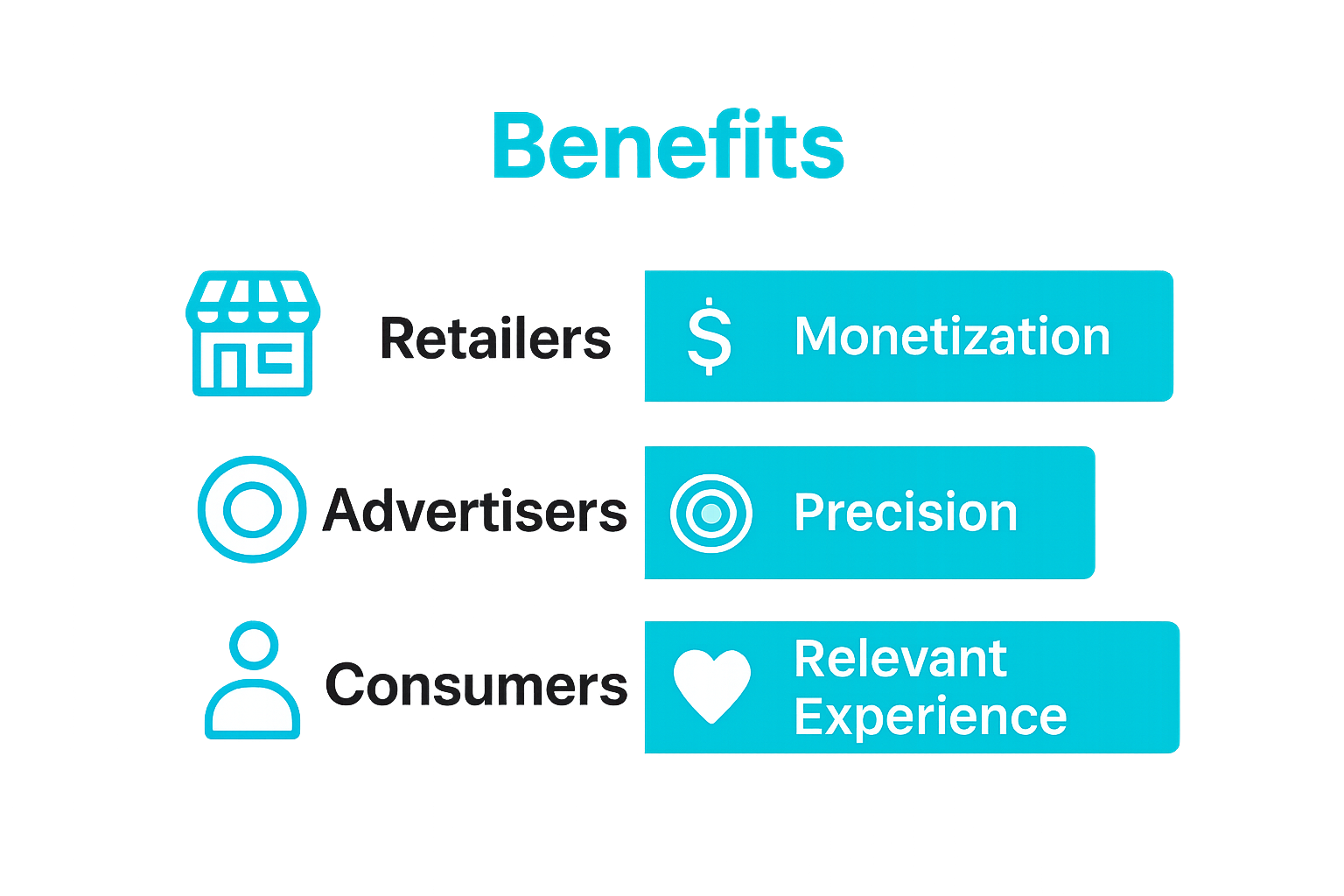Understanding the Future of Retail Media

Brands are pouring billions into online ads, hoping to reach shoppers right where they buy. Incredibly, Amazon alone raked in over $47 billion in advertising revenue in 2023, completely changing the scale of retail media. But the biggest surprise is not just the money—it is how data and technology are quietly turning every click and scroll into gold for retailers and advertisers alike.
Table of Contents
- What Is Retail Media And Its Importance In Today’s Market
- The Evolution Of Retail Media: Why It Matters For Brands And Shoppers
- How Retail Media Works: Key Concepts And Mechanisms
- The Role Of Data And Technology In Shaping Retail Media
- Future Trends: What To Expect In Retail Media
Quick Summary
| Takeaway | Explanation |
|---|---|
| Retail media connects brands with shoppers directly. | Leveraging retailers’ platforms allows brands to reach consumers at critical purchase moments effectively. |
| Data-driven targeting enhances advertising effectiveness. | Utilizing first-party consumer data enables precise audience segmentation and improves ad relevance, leading to higher ROI. |
| Retail media is a growing economic powerhouse. | The sector has expanded significantly, with Amazon generating over $47 billion in ad revenue in 2023, signaling its potential. |
| Technological advancements drive retail media evolution. | Innovations like AI and machine learning enable hyper-personalized advertising, transforming marketing strategies and enhancing consumer engagement. |
| Emerging technologies will reshape consumer experiences. | Trends like augmented reality and immersive content are redefining interactions, making advertising more engaging and personalized. |
What is Retail Media and Its Importance in Today’s Market
Retail media represents a transformative approach to digital advertising where retailers leverage their digital platforms and extensive consumer data to create powerful marketing ecosystems. As consumer shopping behaviors continue to shift online, retail media has emerged as a strategic solution connecting brands directly with potential buyers.
The Fundamental Mechanics of Retail Media
At its core, retail media operates through digital networks where retailers sell advertising space on their online platforms. Learn more about digital marketing strategies that complement these approaches. These networks utilize first-party data collected from customer interactions, enabling unprecedented precision in targeting advertisements.
Key characteristics of retail media include:
- Direct access to consumers at their point of purchase
- Highly granular targeting based on actual shopping behaviors
- Measurable return on advertising investment
Economic Impact and Growth Trajectory
According to research from Columbia Business School, retail media has become a significant economic force. Amazon alone generated over $47 billion in advertising revenue in 2023, signaling the massive potential of this emerging marketing channel.
The future of retail media hinges on its ability to provide value to three critical participants: retailers, advertisers, and consumers. Retailers monetize their digital real estate, advertisers access precise audience segments, and consumers receive more relevant, personalized advertising experiences.
As digital commerce continues expanding, retail media represents not just an advertising strategy, but a fundamental reimagining of how brands connect with potential customers in an increasingly digital marketplace.
The Evolution of Retail Media: Why It Matters for Brands and Shoppers
Retail media has undergone a radical transformation from traditional advertising methods to a sophisticated digital ecosystem that fundamentally reimagines brand-consumer interactions. Explore podcast insights about marketing strategies that complement this digital revolution.
From Traditional Advertising to Digital Precision
Historically, brands relied on broad-based advertising channels with limited targeting capabilities. Retail media represents a paradigm shift, offering unprecedented precision and data-driven targeting. According to research from the Shop! Association, the industry has expanded to a $293 billion sector, signaling a massive transformation in marketing approaches.
Key evolutionary stages of retail media include:
- Transition from generic advertising to hyper-targeted digital placements
- Utilization of real-time purchase data for strategic marketing
- Integration of first-party consumer insights into advertising strategies
The following table compares how retail media has evolved from traditional advertising to advanced digital precision marketing, organizing key characteristics described in the article for easier reference.
| Aspect | Traditional Advertising | Digital Retail Media Precision |
|---|---|---|
| Targeting | Broad, limited targeting | Hyper-targeted, data-driven |
| Data Usage | Limited third-party data | Extensive first-party, real-time |
| Personalization | Minimal | Highly personalized experiences |
| Measurement of ROI | Difficult, less transparent | Transparent, easily measurable |
| Consumer Engagement | General messaging | At point of purchase or decision |
| Scale of Industry | Smaller, fragmented | $293 billion sector (2023) |
Stakeholder Benefits in the New Retail Media Landscape
The evolution of retail media creates a win-win ecosystem for multiple participants. Retailers can monetize their digital platforms, advertisers gain access to precise audience segments, and consumers receive more relevant, personalized product recommendations.
This table summarizes the primary stakeholder benefits of retail media as described in the article, helping clarify the value each group receives from the ecosystem.
| Stakeholder | Key Benefits |
|---|---|
| Retailers | Monetize digital real estate, leverage consumer data for partnerships |
| Advertisers | Access precise audience segments, transparent and measurable ROI |
| Consumers | Receive relevant, personalized recommendations and a better experience |

For brands, this new landscape offers:
- Direct access to consumers at their purchase decision point
- More transparent and measurable return on advertising investment
- Ability to leverage granular consumer behavior data
As digital commerce continues expanding, retail media is not just an advertising strategy but a sophisticated mechanism for understanding and engaging consumers in an increasingly complex digital marketplace.
How Retail Media Works: Key Concepts and Mechanisms
Retail media operates through sophisticated digital platforms that transform traditional advertising models into dynamic, data-driven marketing ecosystems. Learn more about digital engagement strategies that complement these innovative approaches.
The Technical Infrastructure of Retail Media Networks
At its core, retail media networks function as complex digital marketplaces where retailers leverage their first-party consumer data to create targeted advertising opportunities. According to research from NCBI, these platforms integrate advanced customer-interfacing technologies that enable precise audience segmentation and personalized marketing experiences.
Key technological components include:
- Advanced data analytics platforms
- Real-time consumer behavior tracking systems
- Programmatic advertising infrastructure
- Machine learning algorithms for audience targeting
Mechanisms of Targeted Advertising
Retail media networks transform raw consumer data into actionable marketing insights through multiple sophisticated mechanisms. Brands can now access granular targeting capabilities that go far beyond traditional demographic segmentation.
The primary operational mechanisms involve:
- Collecting and analyzing user purchase history
- Tracking browsing and interaction patterns
- Creating dynamic audience segments
- Delivering personalized ad experiences in real-time
These networks effectively bridge the gap between consumer intent, advertising placement, and purchase decision, creating a more integrated and responsive marketing ecosystem that benefits retailers, brands, and consumers alike.
The Role of Data and Technology in Shaping Retail Media
Data and technology have become the fundamental architects of modern retail media, transforming how brands connect with consumers through intelligent, predictive systems. Explore advanced data analytics for shopping insights that illuminate the intricate relationships between consumer behavior and marketing strategies.
Advanced Data Capture and Analysis
Retail media’s technological foundation relies on sophisticated data collection mechanisms that capture nuanced consumer interactions across digital platforms. According to research from the University of Arkansas, artificial intelligence and machine learning have become critical tools for understanding complex consumer patterns and predicting purchasing behaviors.
Key technological capabilities include:
- Real-time behavioral tracking
- Predictive consumer modeling
- Dynamic audience segmentation
- Personalization algorithms
Technological Transformation of Marketing Strategies
Modern retail media transcends traditional advertising by creating intelligent, adaptive marketing ecosystems. Technologies like machine learning and big data analytics enable brands to move beyond demographic targeting toward hyper-personalized consumer experiences.
Core technological innovations driving this transformation involve:
- AI-powered recommendation engines
- Contextual advertising platforms
- Cross-channel consumer journey mapping
- Automated personalization technologies
These technological advancements represent more than mere marketing tools. They signify a fundamental reimagining of how brands understand, engage, and provide value to consumers in an increasingly digital marketplace.
Future Trends: What to Expect in Retail Media
The landscape of retail media is rapidly evolving, driven by technological innovations and changing consumer expectations. Discover optimization strategies for emerging markets that will shape the future of digital advertising and consumer engagement.
Immersive Technologies Transforming Consumer Experiences
Retail media is moving beyond traditional digital advertising toward highly interactive and personalized engagement platforms. According to research from the Advertising Club, emerging technologies like augmented reality (AR), virtual reality (VR), and shoppable video experiences are revolutionizing how brands connect with consumers.
Key emerging technological trends include:
- Augmented reality product visualization
- Virtual try-on experiences
- Immersive 360-degree shopping environments
- Interactive personalized content platforms
AI and Predictive Intelligence in Retail Media
Artificial intelligence is set to become the cornerstone of intelligent, adaptive retail media ecosystems. Advanced machine learning algorithms will enable unprecedented levels of personalization, transforming how brands understand and engage with their target audiences.
Anticipated developments in AI-driven retail media involve:
- Hyper-personalized product recommendations
- Predictive consumer behavior modeling
- Real-time dynamic pricing strategies
- Automated content and advertising optimization
These technological advancements represent more than incremental improvements. They signal a fundamental reconstruction of the relationship between brands, consumers, and digital marketing platforms, promising more meaningful, contextually relevant interactions in the years ahead.

Take Retail Media Into the Next Era With Prodcast
Are you struggling to fully connect your brand with in-the-moment shoppers as highlighted in “Understanding the Future of Retail Media”? The article underscores the challenges of personalizing consumer experiences and capitalizing on real-time purchase intent. As retail media evolves with AI, data-driven targeting, and dynamic engagement, many brands still feel disconnected from true buyer action and miss opportunities at digital touchpoints.

Prodcast empowers marketers and entrepreneurs to overcome these hurdles. Our advanced AI scans podcasts to pinpoint product mentions and user intent, then instantly links listeners to purchase opportunities through integrated Amazon affiliate connections. If you want to transform passive audiences into active shoppers, explore how to showcase your products and bid on high-intent keywords. Do not wait to experience a marketplace built for the voice-driven future of retail media. Visit Prodcast now and claim your place at the forefront of audio commerce innovation.
Frequently Asked Questions
What is retail media?
Retail media is a digital advertising approach where retailers use their online platforms and consumer data to create targeted advertising opportunities, connecting brands directly with consumers.
How does retail media benefit brands?
Retail media offers brands direct access to consumers at their point of purchase, more precise audience targeting based on shopping behaviors, and the ability to measure return on advertising investment.
What technologies are shaping the future of retail media?
Technologies such as artificial intelligence, machine learning, and advanced data analytics are transforming retail media by enabling hyper-personalized consumer experiences and real-time behavioral tracking.
What are some emerging trends in retail media?
Emerging trends in retail media include the use of immersive technologies like augmented reality and virtual reality, as well as advanced predictive intelligence for creating more engaging and personalized consumer interactions.
Recommended
- Podcast Search Optimization for Listeners and Brands 2025 | Prodcast
- Podcast Engagement Metrics: What Brands and Listeners Nee… | Prodcast
- Podcast Data Analytics: Boost Shopping and Brand Sales in… | Prodcast
- Top Influencer Marketing Podcasts Every Buyer Should Hear | Prodcast
- Skipso
- The Future of Video Marketing: Key Trends and Strategies